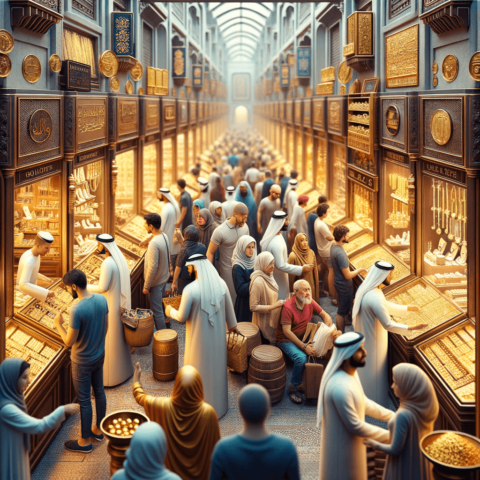
Unveiling the Thrills: New BOUNCE Venue Opens at Forsan Central Mall in Abu Dhabi
July 22, 2024
Dubai’s Flourishing Economy: A Glimpse into the First Quarter of 2024
July 23, 2024As of July 23, 2024, the gold rates in UAE for 24K, 22K, 21K, and 18K were AED 290.25, 268.75, 260.25, and 223.00 per gram, respectively. This article delves into the UAE’s gold market landscape and its future trajectory, catering to tourists and business investors.
Understanding the Current Gold Rates in UAE
When examining the **current gold rates in the UAE** as of July 23, 2024, we observe a particular distribution across various purities. The rate for **24K gold** is noted at AED 228.50 per gram, **22K gold** stands at AED 215.25 per gram, **21K gold** is priced at AED 206.75 per gram, and **18K gold** is at AED 176.50 per gram. These figures are vital to understanding the present state and trajectory of the UAE’s gold market.
In a **comparative context**, we note that gold prices have experienced noticeable fluctuations over the past few months. The rates have been subject to volatility due to global economic uncertainties and shifting investment strategies. Gold prices peaked earlier in the year amidst rising inflation rates and geopolitical tensions but have shown some stabilization more recently.
However, historical data indicates a relatively higher demand for 22K and 24K gold, driven by consumer preferences for purer forms of gold in jewelry purchases. Seasonal trends, particularly during festive periods, often lead to a spike in gold prices due to increased consumer activity. Additionally, the UAE’s strategic position as a global trading hub amplifies these trends, contributing significantly to the nation’s economy.
This multifaceted interplay of economic factors and consumer behaviors continues to shape the current gold rates, reflecting both the dynamic nature of the market and the underlying stability provided by traditional demand patterns. As we delve deeper into the factors influencing these prices, it becomes clear that both local and global elements play critical roles in determining the market direction.
Factors Influencing Gold Prices in the UAE
Several key factors influence the gold prices in the UAE, significantly affecting both short-term and long-term trends.
The interplay of **supply and demand** forms the backbone of gold pricing. In the UAE, consumer jewelry purchases represent a substantial chunk of gold demand. Festivals, weddings, and cultural events often see a spike in jewelry buying, which can push prices higher. Moreover, **institutional investors** such as banks and hedge funds frequently turn to gold as a safe-haven asset, particularly during economic downturns, further influencing prices.
Global economic conditions play a pivotal role. An unstable global economy generally bolsters gold prices as investors seek refuge in this precious metal. Conversely, robust economic growth might ease upward pressure on gold as riskier investments become more attractive. **Oil prices** are especially pertinent for the UAE. As a major oil producer, the UAE’s economic well-being is closely tied to oil prices. Higher oil revenues often lead to greater economic stability and can indirectly impact gold demand positively.
**Geopolitical factors** must also be considered. The Middle East’s geopolitical landscape can be volatile, and tensions often lead to increased investment in gold as a hedge against uncertainty. Events such as conflicts, trade disputes, and political instability can all cause fluctuations in gold prices.
Furthermore, the transition to **digital investments** is reshaping the market. The rise of online trading platforms has made gold more accessible, broadening the investor base and affecting supply and demand dynamics.
In summary, the gold market in the UAE is influenced by a complex web of factors, including local consumer behavior, institutional investment trends, global economic conditions, oil prices, and geopolitical events, along with a growing shift towards digital investments. Understanding these dynamics is crucial for predicting future price movements.
The UAE as a Global Gold Trading Hub
With its strategic location and robust infrastructure, the UAE has solidified its status as a significant player in the global gold market. Key markets for the UAE’s gold imports include India, Switzerland, and the USA. Historically, India has been a major destination for UAE’s gold, driven by insatiable consumer demand for jewelry. In contrast, Switzerland serves as a critical hub for refining and re-exporting, leveraging its advanced processing facilities.
Switzerland remains the UAE’s foremost partner, accounting for a significant share of gold exports. Recent data underscores this partnership: for instance, in 2019 alone, the UAE exported gold worth over $8 billion to Switzerland. The USA, while primarily an importer of UAE’s gold jewelry, also plays a vital role given its substantial gold reserves and robust investment demand.
The **Dubai Gold Souk** stands at the heart of this vibrant trade, combining traditional and modern trading techniques. This marketplace, with its labyrinth of over 300 retailers, has been instrumental in bolstering Dubai’s reputation as the “City of Gold.” Its historical and economic significance cannot be overstated. Daily foot traffic in the souk includes tourists and traders from around the globe, reinforcing Dubai’s pivotal role in the gold supply chain.
Unlike any other market, *Dubai’s duty-free policies,* *state-of-the-art infrastructure,* and *pro-business regulations* ensure competitive pricing and high liquidity. The Dubai Multi Commodities Centre (DMCC)’s Gold & Commodities Exchange (DGCX) further facilitates streamlined trading operations, propelling the UAE’s position as a leader in the global gold trade. As the UAE continues to cultivate strategic alliances and leverage technology, its influence in the gold market is poised for enduring growth.
Future Trajectories for UAE’s Gold Market
Analyzing the future trajectories of the UAE’s gold market reveals numerous influential factors. The country’s relationship with **oil prices** plays a crucial role. As one of the world’s leading oil producers, the UAE’s economic stability is often linked to fluctuations in oil prices. When oil prices rise, the increased revenue can lead to higher disposable incomes, which may spur greater investment in gold. Conversely, lower oil prices could potentially impede this trend.
**Global economic growth** is another determinant. As the world economy thrives, so does consumer confidence and spending power, particularly in emerging markets. This trend could positively affect demand for gold within the UAE, whether for investment purposes or luxury consumption. On the other hand, economic downturns globally might shift investor preference toward gold as a safe-haven asset, boosting its demand in the UAE market.
A significant evolution is the shift from **physical to digital gold investments**. With the advent of blockchain technology and digital trading platforms, more investors are gravitating towards digital gold. This shift is augmented by the UAE’s strong technological infrastructure and forward-thinking **government policies** that encourage innovation and fintech solutions. Digital gold offers advantages such as ease of transaction, security, and lower storage costs, making it increasingly attractive.
The UAE’s **infrastructure and international initiatives** further buttress its gold industry. Robust trading facilities, free zones like DMCC (Dubai Multi Commodities Centre), and strategic partnerships with major gold trading nations ensure that the UAE remains a pivotal player in the gold market. The government’s continuous efforts to enhance transparency and regulatory frameworks also contribute to sustained growth.
In analyzing these multifaceted dynamics, it is evident that the UAE’s gold market is poised for a future marked by both opportunities and challenges. From fluctuating oil prices to rapid digitalization, the landscape remains as glittering as the commodity it treasures.
Understanding Carat/Karat Measurements of Gold
The significance of **carat/karat measurements** in gold cannot be overstated, particularly when it comes to understanding the purity and suitability of gold for various applications, most notably in jewelry. Gold purity is measured in karats, with **24K** being the purest form of gold, consisting of 99.9% gold. This high purity gold is often too soft for most types of jewelry but is highly valued for its aesthetic and financial worth.
**22K gold**, containing about 91.6% gold, strikes a balance between purity and durability, making it a popular choice for high-end jewelry in the UAE. Despite its rich gold content, it includes a small percentage of other metals like copper or silver to enhance its durability.
**21K gold** includes around 87.5% gold and is commonly used in fine jewelry across many Middle Eastern countries. The slight reduction in gold content means it’s less susceptible to scratches and dents, increasing its desirability for everyday wear.
**18K gold**, comprising 75% gold, is a staple choice for many jewelers worldwide. Its combination of significant gold content and added metals makes it durable and perfect for intricate designs and detailed craftsmanship, appealing to a broad consumer base.
**14K gold** (58.5% gold) and **9K gold** (37.5% gold) are more robust choices frequently used in Western markets. These lower karat ratings introduce a higher percentage of other metals, making the gold harder and more resistant to wear and tear. They’re ideal for items like rings or bracelets that undergo daily wear.
Understanding these various karat measurements is crucial for both consumers and investors. Consumers can make more informed decisions about their jewelry purchases, considering both aesthetic preferences and practical durability. Investors, on the other hand, can appreciate the nuances in gold content when evaluating market trends and investment opportunities in the UAE’s dynamic gold sector.
Conclusions
The UAE continues to solidify its position as a pivotal player in the global gold market. Despite potential challenges like fluctuating oil prices and a shift towards digital investments, its robust infrastructure and strategic policies offer a promising future. Staying informed about the latest gold rates and market dynamics is essential for investors and tourists alike.





